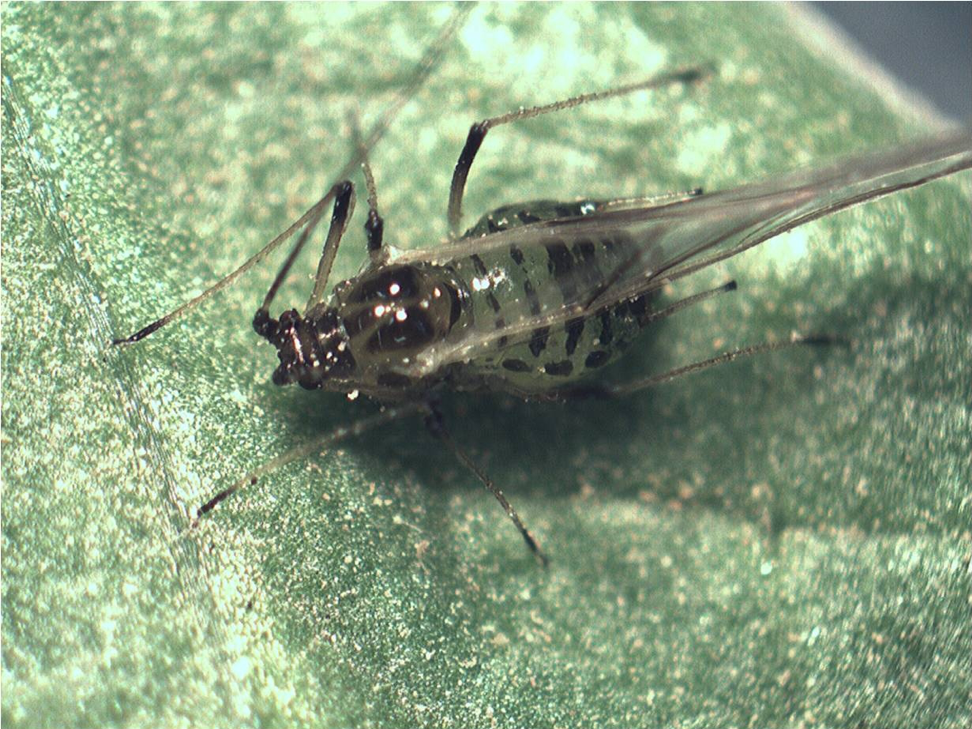
|
|
|
|

|
|||
|
|
|||
Overall insect pressure has been below average this fall in my estimation. Of course, there have been a few surprises like bagrada bug incidence, and heavy worm and/or whitefly pressure in some isolated areas. However, these pests should start to decline quickly as winter approaches. With the seasonal transition of cooler temperatures, along with shorter days and consistent N-NW winds, you will likely begin to see an increase in winged aphids showing up on desert produce crops. Winged aphid numbers on yellow sticky traps have suddenly increased in the North Gila and North Yuma Valleys over the past 2 weeks or so (see Areawide Trapping Network ). This is not a surprise; experience tells us that this is an annual occurrence. The key aphid pests found on winter produce (i.e., green peach aphid, foxglove aphids) do not over-summer here, rather they migrate into our cropping system from mountainous regions of southern California via wind currents during the fall. Once the aphids reach our desert valleys, they typically land on native vegetation and then into produce fields, moving among weeds and crops until they find a suitable host to feed and colonize on. No need to panic if you suddenly find a few winged aphids on a lettuce plant. But it is important that you correctly identify the aphid species present. It is not uncommon to find winged aphids on lettuce that do not colonize on the crop. For example, winged cabbage aphids can typically be found on lettuce this time of the year but will not colonize on the plants. Other examples of winged aphids that can be found on produce crops would include aphids that colonize small grains (i.e., oat bird-cherry aphid) or alfalfa (i.e., blue alfalfa aphid). Because these aphid species will not colonize produce crops, it is important to be able to distinguish them from the aphids that do colonize and require management to prevent problems at harvest (i.e., green peach aphid, foxglove aphid, lettuce aphid, cabbage aphid, turnip aphid). Proper aphid ID can also influence your choice of insecticide, but more on that in a later update. Don’t be surprised if you start finding small colonies of cowpea aphids or melon aphids showing up on frame leaves in lettuce. That is a common occurrence every fall. Not to worry, experience has shown us that although small cowpea aphid colonies may be found on lettuce, the populations generally stay low on the plant on the frame leaves and rarely increase to levels causing contamination issues. But you never know. So, keep a close watch out for these aphids found in your crops, as our weird weather this year may be more conducive to their development than normal. Bottom Line: proper aphid identification is important; it can save a PCA time and money and prevent unnecessary insecticide applications. If you find an unusual aphid in your produce, don’t hesitate to drop it by the Ag Center and we’ll get it identified for you. If you want to make fast and accurate IDs, you might use the attached publication Aphid Identification in Desert Produce Crops that can assist you in identifying winged and wingless (apterous) aphids important in leafy vegetables and cole crops. | |||
| Back | |||
|
For questions or comments on any of the topics please contact Marco Pena at the Yuma Agricultural Center.
|
|||
|
Home |
Cotton | Veggies |
Forages | Grains
| Citrus |
Crop x Crop Insects | Diseases| Weeds | Pesticides | Economics | News | Weather | Research | Photos | Contacts | General Info. Copyright © 2001 University of Arizona, College of Agriculture and Life Sciences Webmaster: Al Fournier (acis@ag.arizona.edu) |
|||

